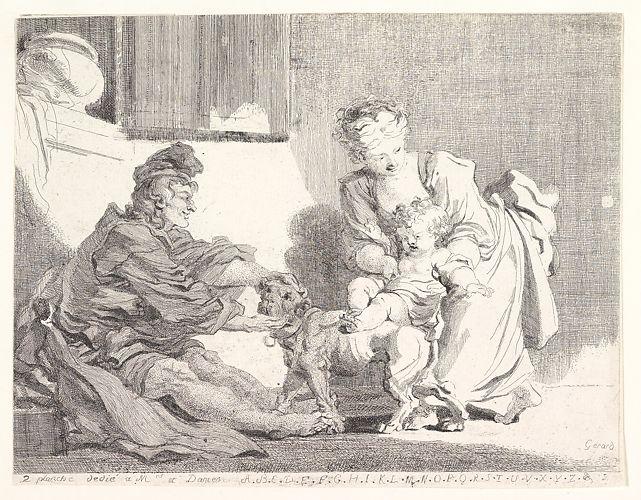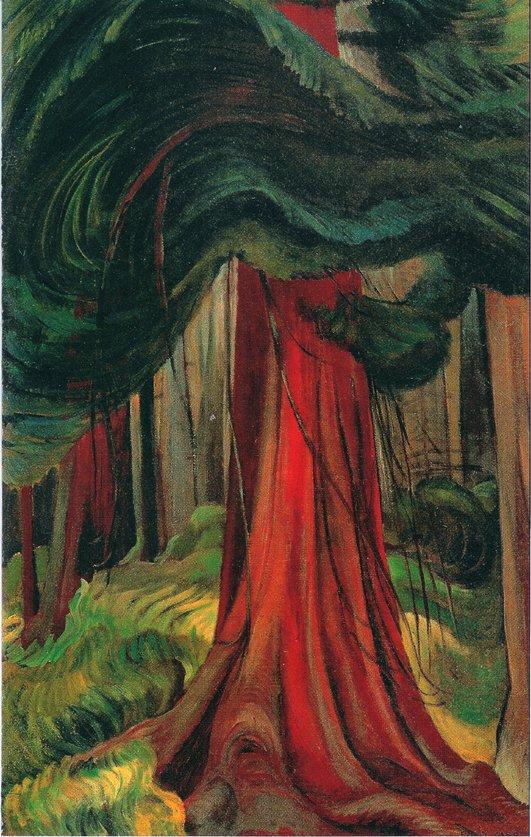The Rococo painter Marguerite Gerard (1761-1847), born in Grasse, France, specialized in genre paintings of mothers and children. Marguerite’s father Claude Gerard was a distiller of perfume. Grasse, on the hills north of Cannes, was and continues to be known as the perfume center of the world. Following the death of her mother when Gerard was fourteen, she went to live in Paris with her older sister Marie-Anne and her husband. Marie-Anne was a miniaturist and the spouse painter Jean Honore Fragonard. Fragonard and his family lived in the Louvre, at that time the royal palace, and Gerard had access to study the royal collection and the opportunity to meet many important French artists.
Gerard wanted to be an artist, and by 1778 she had become Fragonard’s student and assistant. Together they created nine etchings between 1770 and 1778. “The Child and the Bulldog” (1778) (etching 6.75” x 8.75”) (Metropolitan Museum of Art, New York City) is Gerard’s copy of Fragonard’s original drawing titled “The First Riding Lesson.” The quality of the work suggests Gerard was talented and a quick learner, able to depict the scene accurately and artistically. At the time, Fragonard and Marie-Anne had two children, a girl and a boy. The young boy about to ride the Bulldog likely is her nephew, Alexandre (b.1770). Although Gerard never married or had children, she helped to raise the Fragonard children. Mothers and children became her chosen subject matter.
Gerard and Fragonard collaborated on several of her early paintings, for example, “The Beloved Child’ (1780-85) (23.75 x 28.75’’) (Fogg Museum, Harvard University). The choice of the subject of mother and child subject was Gerard’s. A young, beautiful, and well-dressed mother pulls her child in a gilded red carriage through a lush landscape. Her pink silk dress is covered by a sheer white and green gown with a ruffled neckline. She pulls the carriage with her pink shawl. Her hair is piled on her head in loose curls, tied with a ribbon. She smiles at her baby, who holds onto his ginger cat and waves back. Her companion, perhaps a sister or a nursemaid, pushes the carriage.
Gerard had a fondness for cats and dogs, and she often included them in her paintings. Ears flapping and tails wagging, two white dogs are enthusiastic participants in the scene. A young boy with a garden rake smiles at the baby. Flowers are clustered in the foreground, and a bouquet rests on the light pink cushion in the carriage. This happy group runs gently through the scene, their drapery flowing on the breeze.
By 1785, Gerard had established a reputation as a genre painter, depicting family life. She was the first French painter to make genre popular. Her style was largely derived from her observation of the 17th Century Dutch masters Gabriel Metsu (1629-1667) and Gerard ter Borch (1617-1681). In “Sleep My Child” (1783-1786) (21.5’’ x 17.7’’) Gerard depicts the figure of the mother in 17th Century dress, a fur-lined jacket and heavy silk skirt. Her rendering of the texture of the skirt is particularly Dutch, and she places the mother and sleeping baby in a simple and modest interior. Gerard often depicted women playing musical instruments. In this painting the mother plays a guitar as she smiles and sings a lullaby to her sleeping baby. It is a quiet and peaceful scene.
Gerard abandoned the typical Rococo subject matter that consisted of the frivolous treatment of the loves of the Greek gods, and amorous encounters full of sensuous innuendo. Gerard placed mother and child images in middle-class interiors to give to her subject matter the seriousness and clarity she believed it deserved. During the reign of Louis XV (1740’s until 1770’s), French nobility moved from the grandeur of the Palace at Versailles into the city of Paris. Hotels and townhouses were abundant. An educated bourgeoisie opened salons, shops, and cafes. The flamboyant party atmosphere of Versailles continued in the city. Gerard’s middle-class genre and smaller painting, that fit into the smaller rooms, only increased the market for work. Her paintings continued to sell well, and prints made from them were popular with the middle class because of their reduced price.
“First Steps” (1788) depicts an abundance of mothers and children. Two mothers at either side of the composition hold scarves around their children who struggle to stand upright and take their first steps. The center of attention is the blond baby in the woven Rococo version of a stroller. A young girl and a small dog also look on. The babies are all chubby cherub types. The sashes used to hold the three babies who want to walk are gathered in such a way as to suggest angel wings.
The women are dressed in the Empire style that became more and more popular as the troubles of the French government under Louis XVI (1774-1793) increased. The Empire style, introduced to Marie Antoinette by her court painter Elisabeth Vigee-Lebrun, was intended to recall the strength of the Roman Empire and the virtue of the government. The simple white gown suggested purity and simplicity.
“Motherhood” (1795-1800) (20’’x 24’’) (Baltimore Museum of Art) depicts a simple middle-class interior, a young mother gently holds her baby while he kisses her on her cheek. A smiling maid looks on, and a fluffy white, spotted cat completes the three white elements in the composition, including the white dress of the maid, and the white dress of the mother. Gerard developed a glaze medium using several translucent colors to paint her favorite white satin dresses.
Gerard survived the Revolution and Restoration and began exhibiting in open Salon Exhibitions from 1799 until 1824, winning three medals. She maintained a studio in the Louvre, and made portraits of several of the delegates to the National Convention that tried and executed Louis XVI and Marie Antoinette. She contributed funds to pay war debts by selling her jewelry. Gerard survived the death of Fragonard in 1806, and the death of her sister in 1824. She became head of Fragonard’s large family. Gerard invested her earnings in real estate and government annuities, amassing a large fortune. Never married, she continued to paint tender scenes of mothers and children. Three hundred genre paintings, 80 portraits, and several miniatures are still in existence. Gerard was an independent woman of talent and means, unusual for women of her time.
Beverly Hall Smith was a professor of art history for 40 years. Since retiring with her husband Kurt to Chestertown six years ago, she has taught art history classes at WC-ALL and Chesapeake College’s Institute for Adult Learning. She is also an artist whose work is sometimes in exhibitions at Chestertown RiverArts and she paints sets for the Garfield Center for the Arts.





















